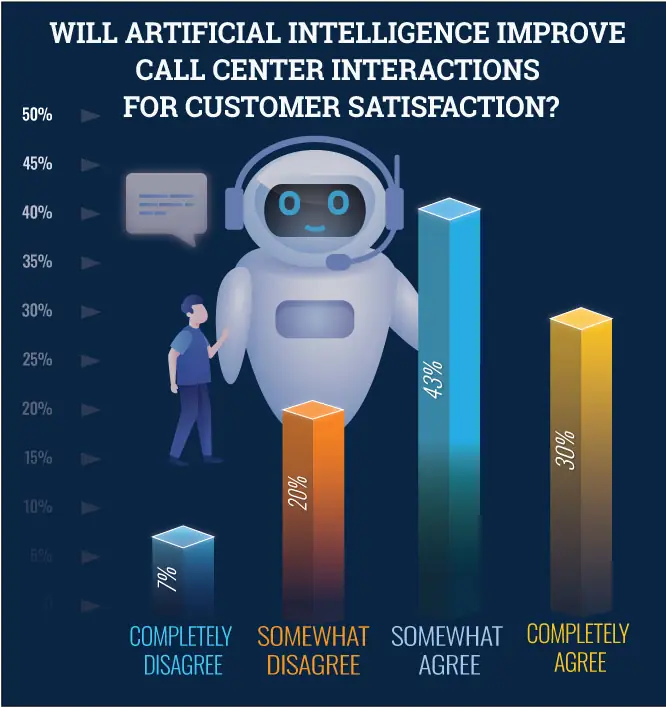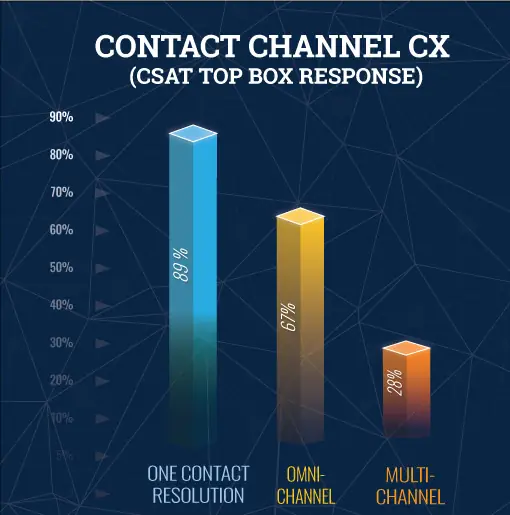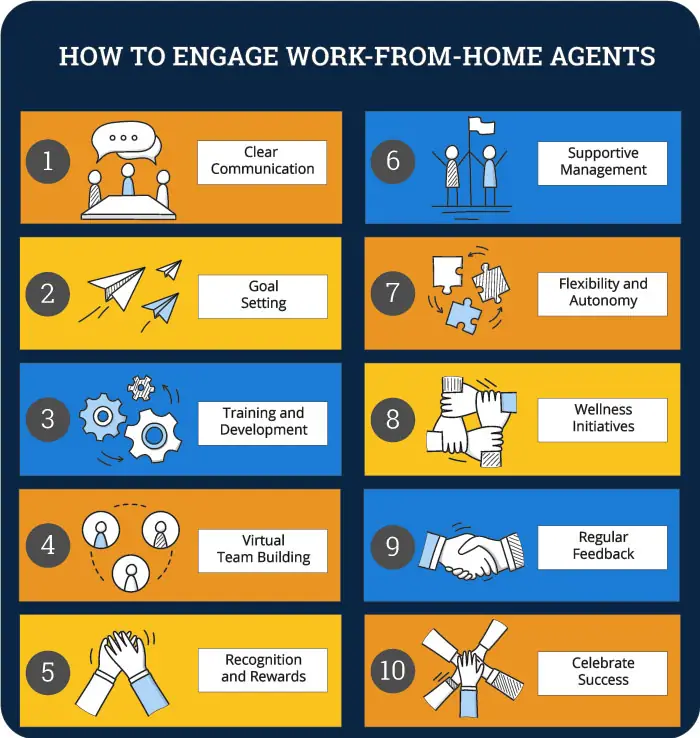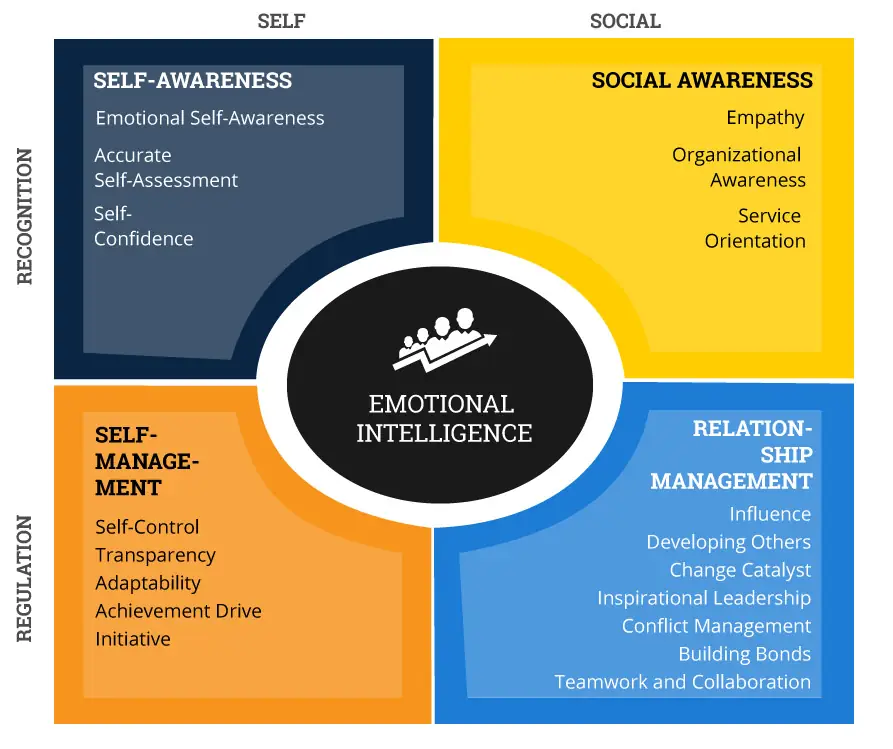As we move into 2024, several key developments stand to redefine how businesses connect with their customers, blending technology and human-centric approaches to elevate the customer experience. From AI-driven interactions to the emphasis on emotional intelligence, understanding these trends is not just beneficial—it's essential for any contact center aiming to excel in service delivery and customer satisfaction.
Here are five trends that contact centers should be keeping an eye on for 2024:
Trend 1: Artificial Intelligence (AI) in Contact Centers
AI is no longer a buzzword but a tangible asset in modern contact centers. This technology revolutionizes how businesses interact with their customers, making the process faster, more efficient, and increasingly personalized.
SQM Group's research shows that 73% of call center professionals somewhat or completely agree that Artificial Intelligence will improve call center interactions for customer satisfaction.

AI-Powered Chatbots for Customer Support
AI-powered chatbots have become indispensable in handling routine customer inquiries without human intervention. These chatbots are programmed to understand and process natural language, allowing them to provide instant responses to customers 24/7. This not only improves customer satisfaction by reducing wait times but also allows human agents to focus on more complex issues that require a personal touch.
For example, many websites have an AI chatbot that pops up in the corner of the screen with text bubbles such as, "Can I help you find what you're looking for?" These can be very convenient for more simple queries, like if a customer has specific questions about a product or service.
As AI technology evolves, these chatbots become more adept at understanding context, making their interactions with customers surprisingly human-like.
AI-Driven Sentiment Analysis for Better Customer Understanding
Another significant advantage of AI in contact centers is its ability to perform sentiment analysis. By analyzing customers' words and tone, AI can gauge their emotions and satisfaction levels during interactions. This provides invaluable insights into customer attitudes and allows contact centers to tailor their approaches accordingly. It enables agents to address potential issues proactively and personalize communication, thus enhancing the customer experience.
Trend 2: Omnichannel Approach for a Seamless Customer Experience
The concept of an omnichannel approach is simple yet powerful: provide a seamless and consistent customer experience across all platforms and communication channels. This strategy acknowledges that customers interact with businesses through multiple mediums and expects each interaction to be cohesive and interconnected.
Multi-channel contact centers have multiple channels, which are not integrated, so customers cannot seamlessly switch between channels. Whereas omnichannel contact centers have multiple integrated channels, allowing customers to switch and pick up where they left off.
In a multichannel contact center, "multi" refers to using multiple communication channels to interact with customers. A multichannel approach allows customers to choose their preferred method of communication while the company manages each channel separately. This implies that if a customer placed a phone call last week and used the live chat today, the agent might not have access to a consolidated view of their complete interaction history.
In the context of an omnichannel contact center, "omni" refers to a more holistic approach. An omnichannel strategy focuses on providing a seamless and consistent customer experience across all channels. This means customers can start an interaction on one channel and continue it on another without losing context.
An omnichannel strategy aims to unify customer data and interactions across channels, allowing for a more personalized and cohesive experience. Whereas a multichannel strategy solely aims to provide more communication channel options without connecting them.
Most SQM call center clients do not feel their touchpoints are fully integrated. However, 43% of their customers who use multiple touchpoints to resolve the same inquiry or problem thought it was a seamless experience. Given that the touchpoints are not fully integrated, SQM has concluded that the way the agent handled the call made the customer feel it was a seamless experience.

Omnichannel contact centers have higher Csat than multichannel contact centers; however, most customers do not wake up in the morning and say they want to use two contact channels to resolve the same inquiry or problem. In other words, what most customers want is a One Contact Resolution for resolving an inquiry or problem. One Contact Resolution means one channel and one contact to resolve an inquiry or problem.
Integration of Multiple Communication Channels
Integrating various communication channels such as email, social media, live chat, and voice calls into a single, unified system is at the core of the omnichannel approach. This ensures that customer interactions are not siloed but part of a continuous conversation, regardless of the channel through which the customer engages.
For example, a query initiated via live chat can be smoothly transitioned to a voice call, if necessary, without needing the customer to repeat information. This level of integration greatly enhances efficiency and customer satisfaction.
Personalized and Consistent Customer Experience Across Channels
An effective omnichannel strategy emphasizes the availability of multiple channels and the consistency and personalization of the customer experience across these channels. It leverages customer data to provide personalized interactions, recognizing the customer and their history regardless of the medium used.
This approach reduces frustration caused by disjointed interactions and builds a strong, loyal relationship between the customer and the brand. Personalization, based on the understanding of customer preferences and past interactions, ensures that the communication is relevant, timely, and increasingly effective, fostering a sense of being valued and understood.
Trend 3: Remote Workforce in Contact Centers
The shift towards a remote workforce in contact centers has been nothing short of revolutionary. As businesses adapt to the digital age, the flexibility and global reach offered by remote teams have become invaluable assets. This trend not only caters to the changing lifestyle of the modern worker but also opens a world of possibilities for contact center operations.
However, the shift to remote work has also had some negative effects such as higher turnover, increased job burnout, and absenteeism. Furthermore, recent SQM Group research shows that 47% of managers feel their biggest problem operating a call center effectively and efficiently is high agent turnover, job burnout, and absenteeism.
Advantages of Remote Work for Contact Center Agents
Remote work offers many benefits for contact center agents. Firstly, it provides a better work-life balance, reducing commute times and allowing for a more flexible schedule. This flexibility often leads to increased job satisfaction, and a broader talent pool from which companies can recruit. Moreover, remote work can lead to cost savings for both employees and employers, as there is less need for physical office space and resources.
Tools and Technologies for Effective Remote Collaboration
Investing in the right tools and technologies is crucial to ensure the effectiveness of a remote contact center team. Cloud-based contact center software enables agents to access customer data and support tools from anywhere, ensuring seamless customer experience. Cybersecurity tools and VPNs are critical for protecting sensitive customer data in a remote work environment.
Challenges and Solutions for Managing Remote Contact Center Teams
While remote work has its advantages, it also presents unique challenges. Ensuring consistent performance and productivity, managing time zones, and fostering team cohesion can be difficult. Solutions include establishing clear remote work policies, using performance management software to track and measure productivity, and regularly scheduling virtual team-building activities. By addressing these challenges head-on, managers can create a thriving remote work environment for their contact center teams.
Agent engagement remains low for the call center industry and has been an Achilles heel for the 25 years SQM has measured it. Unfortunately, working remotely does no favors to agent engagement. In fact, agent engagement has decreased since switching to the work-from-home model.
SQM's agent engagement research shows that only 27% of agents are highly engaged, 10% are engaged, 57% are indifferent to working in the call center, and 5% are highly disengaged. Agents with an indifferent or disengaged engagement rating are likely to be part of the great resignation and quiet quitting employees working at the call center.
Engaging work-from-home call center agents is crucial for their productivity, motivation, and overall job satisfaction. Here are the top 10 tips to help you engage your remote call center agents effectively:

For example, many remote workers feel disconnected from their coworkers because they no longer have those daily interactions at the coffee machine or during breaks. Instead, they have to schedule conversations or chat via messages. A great way to counter this issue is to host weekly team-building meetings, whether these are virtual or in-person.
Trend 4: Data Analytics and Insights for Personalized Service
In an era where personalized service is not just appreciated but expected, data analytics and insights have become fundamental in shaping the strategies of contact centers. By effectively leveraging data, contact centers can offer customized experiences, anticipate customer needs, and streamline their operations.
One of the significant advantages of using call center analytics software is data visualization. Dashboards are a great example of this as they give a bird's eye view of the call center data and activity. mySQM™ QA Dashboard uses data visualization tools such as gauge chart widgets (e.g., mySQM™ QA, FCR, Csat, and action alerts). In addition, color coding (e.g., red, yellow, and green) allows users to quickly review the dashboard to determine their customer service QA performance and quickly identify areas they need to improve.

Utilizing Big Data to Derive Actionable Insights
Big data analytics enables contact centers to sift through vast amounts of customer interactions and feedback, turning them into actionable insights. By analyzing trends, preferences, and behaviors, businesses can tailor their services and communications to meet the individual needs of their customers. This level of personalization enhances customer satisfaction and loyalty.
For example, organizations can track AHT and FCR and see how they correlate with Csat scores across the board. These insights are invaluable because rather than guessing what could be the best solution, managers can see the correlation in plain sight and create an action plan from those insights.
Predictive Analytics for Proactive Customer Service
Predictive analytics takes customer service to the next level by anticipating and addressing customer issues before they escalate. Using historical data, predictive models can identify patterns and predict future customer behavior, allowing contact centers to proactively engage customers with solutions, recommendations, or promotions, thereby improving the overall customer experience.
Performance Metrics and KPIs for Measuring Contact Center Success
To continuously improve, contact centers must measure their performance against key metrics and KPIs such as First Call Resolution, average handle time, customer satisfaction scores, and net promoter scores. These metrics provide valuable insights into the effectiveness of customer service strategies, the efficiency of operations, and areas for improvement. By closely monitoring and analyzing these KPIs, contact centers can make data-driven decisions to enhance service delivery and achieve greater success.
Trend 5: Emphasis on Emotional Intelligence
The pivot towards emphasizing emotional intelligence (EI) in contact centers underscores a critical evolution in customer service. Recognizing the immense value of emotional intelligence is not just a trend; it's a strategic maneuver to enhance customer relations and operational efficiency. Contact centers that invest in emotional intelligence stand to revolutionize the way they connect with customers, ensuring interactions are not only efficient but also empathetic and personalized.
The following four attributes collectively contribute to emotional intelligence, enabling individuals to navigate their own emotions and relationships successfully.

For example, training agents on some essential emotional intelligence tools, such as active listening skills, emotional regulation, and conflict resolution, can drastically affect how well they can resolve calls and connect with customers.
In order to bring out the best in yourself, it's helpful to assess your emotional intelligence. One easy method to understand your EI is to complete Mindtool's free emotional intelligence questionnaire. To get the most out of the EI questionnaire by completing 360-degree feedback, in which you evaluate your EI and can compare it to others' (e.g., peers, supervisor) opinion of your EI.
On Mindtool's EI questionnaire, evaluate each statement as you actually are rather than as you think you should be. When you've finished, click "Calculate My Total" to determine your Emotional Intelligence rating.
Benefits of Emotional Intelligence in Contact Centers
Deploying emotional intelligence within the contact center environment brings many benefits, crucial for staying ahead in the competitive landscape:
- Improved Customer Satisfaction: Agents skilled in emotional intelligence can better understand and manage customer emotions, leading to more successful resolutions and improved Csat. They can tailor their responses to the customer's emotional state, making each interaction more personal and effective.
- Enhanced Agent Performance: Emotional intelligence fosters a more supportive and collaborative work environment. Emotionally intelligent agents are more resilient, handle stress better, and possess superior problem-solving skills. This improves their performance and contributes to higher job satisfaction and retention rates.
- Increased Sales and Customer Loyalty: By establishing a deeper emotional connection with customers, emotionally intelligent contact centers can significantly increase the likelihood of repeat business. Customers feel valued and understood, which is paramount for loyalty and brand advocacy.
- Conflict Resolution: EI equips agents with the necessary skills to de-escalate conflicts more effectively, ensuring smoother resolutions to customer issues. This capability is invaluable, as it helps maintain positive customer relations, even in challenging situations.
Emphasizing emotional intelligence in contact centers is an undeniable trend with far-reaching implications for customer experience and business success. As contact centers continue to evolve, EI will remain a cornerstone of innovative customer service strategies.
